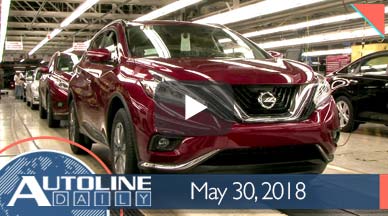
Runtime: 7:29
0:30 Nissan Slashes North American Production
1:18 Kia Names New Head of U.S. Operations
1:41 Jeff Bracken to Retire from Lexus
2:39 California to Test Digital License Plates
3:19 Panasonic Developing Cobalt-Free Batteries
4:19 GM Explains South Korea Decision
Visit our sponsors to thank them for their support of Autoline Daily: Bridgestone , Dow Automotive Systems , Lear Corporation , BorgWarner and ExxonMobil.
On today’s show…Panasonic is developing batteries that don’t use cobalt…due to slumping sales, Nissan is slashing production in North America…and General Motors explains why it’s keeping its operations in South Korea. All that and more coming right up on Autoline Daily.
This is Autoline Daily the show for enthusiasts of the automotive industry.
NISSAN SLASHES NORTH AMERICAN PRODUCTION
Nissan is struggling in the American market this year. The company’s sales plunged nearly 30% in April and through the first four months of the year, sales are down 6.5%. Because of this, it’s inventory is piling up. According to WardsAuto, the company had 88 days of supply at the end of April. So it’s not surprising to learn that Nissan is cutting production this summer to reduce its inventory. Bloomberg reports that the company will slash production by 20% at five of its plants in the U.S. and Mexico. This is part of a strategy to boost profitability in North America. Last year the company grew its market share by boosting incentives and fleet sales, but that ended up cutting into its profit margin.
KIA NAMES NEW HEAD OF U.S. OPERATIONS
At the beginning of April, Michael Sprague, the Chief Operating Officer of Kia Motors America, abruptly left the company. And now Kia has finally announced his replacement. Michael Cole, who’s currently the COO of Kia Motors Europe, has been tapped to replace Sprague. He will be in charge of sales, marketing and product planning functions in the U.S.
JEFF BRACKEN TO RETIRE FROM LEXUS
And speaking of management changes, Lexus has announced that its group vice president and general manager, Jeff Bracken will be replaced by David Christ. It doesn’t seem to have to do with performance. Lexus’ sales are up 2 and a quarter percent so far this year. Bracken, who’s been a guest on our shows several times in the past, will take over the role of executive advisor to Lexus until August 1st, at which time he will retire after 40 years within the Toyota group.
And we’ll be back with more right after this.
CALIFORNIA TO TEST DIGITAL LICENSE PLATES
You may remember from our coverage of the National Automobile Dealers Association trade show, a company by the name of Reviver that’s trying to get people to buy into the idea of digital license plates. Well, we just learned that California is finally rolling out a pilot program for the plates. They’re also approved for Texas, Florida and Arizona, so I’ve got to imagine those states will keep an eye on the California test. But at the time of NADA a whole lot of you commented that the price would keep you from buying a digital plate. Go back to watch the video to find out just how much. It may shock you.
PANASONIC DEVELOPING COBALT-FREE BATTERIES
As we’ve reported recently, prices for cobalt, which is used in lithium-ion batteries, has quadrupled in just the last two years and Chinese companies dominate the supply chain. That has left top battery makers scrambling to reduce the amount of cobalt they use in their batteries and now Panasonic has announced it wants to make batteries with no cobalt. It says development is already underway and hopes to achieve its goal in the near future. We thought the cost of making batteries may not come down as fast as some have predicted, but there’s still reason to be hopeful.
Coming up next, General Motors explains its decision to remain in South Korea.
GM EXPLAINS SOUTH KOREA DECISION
Due to plummeting sales and high labor costs, General Motors considered pulling out of the South Korean market. But a little more than a month ago, GM was able to make a deal with its workers and the South Korean government to keep its operations going. On Autoline This Week, we were joined by Dan Ammann, the President of GM, and he talked about the company’s decision to stay in South Korea.
(The ATW preview is only available in the video version of today’s show.)
You can watch that entire discussion with Dan Ammann right now on our website, Autoline.tv or you can find it on our YouTube channel.
And don’t forget to join us this Thursday for Autoline After Hours when we’ll have Brian McKay, the head of powertrain technology for North America for the supplier Continental. If you have any powertrain questions funnel them our way to viewermail@autoline.tv, then join us live at 3PM eastern time for some of the best inside talk in the automotive industry.
But that’s it for today, thanks for watching and please join us again tomorrow.
Thanks to our partner for embedding Autoline Daily on its website: WardsAuto.com

John McElroy is an influential thought leader in the automotive industry. He is a journalist, lecturer, commentator and entrepreneur. He created “Autoline Daily,” the first industry webcast of industry news and analysis.




